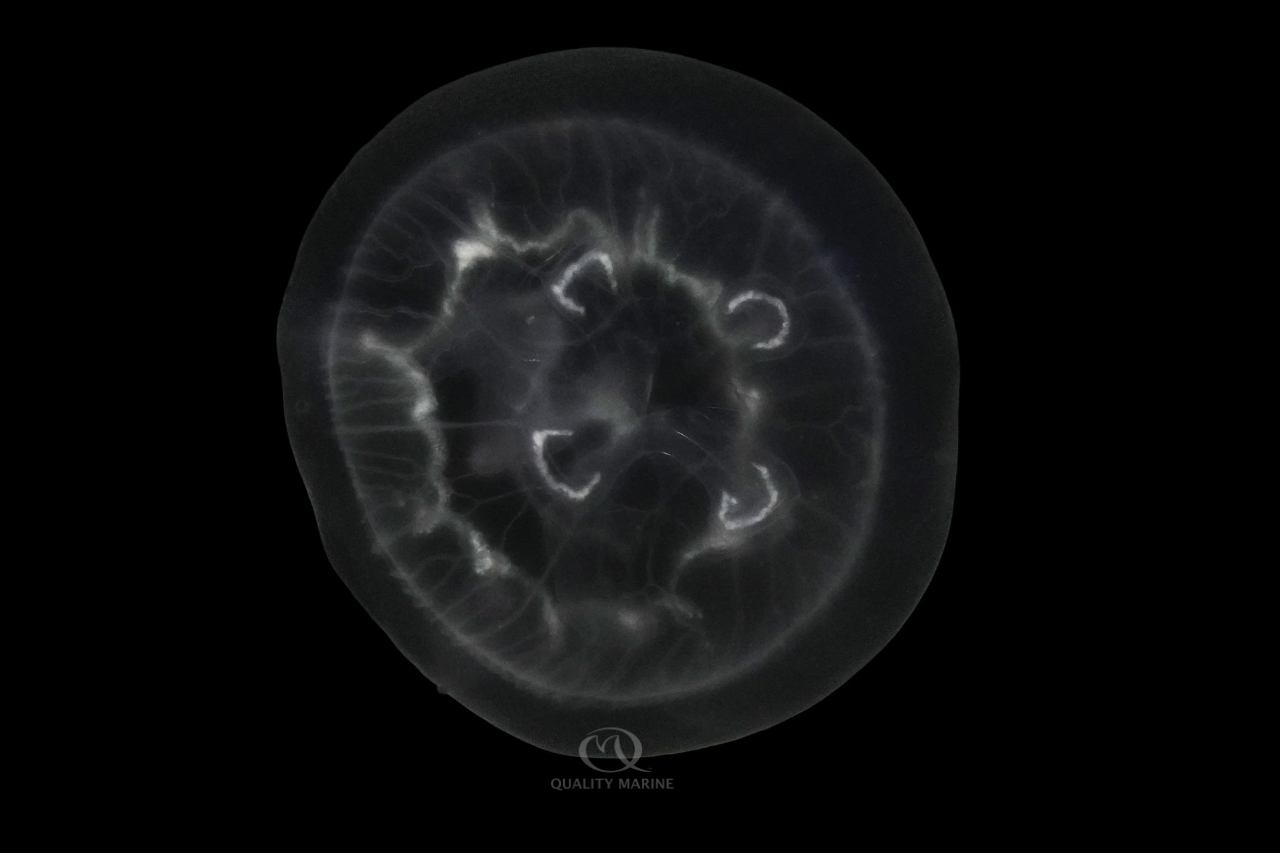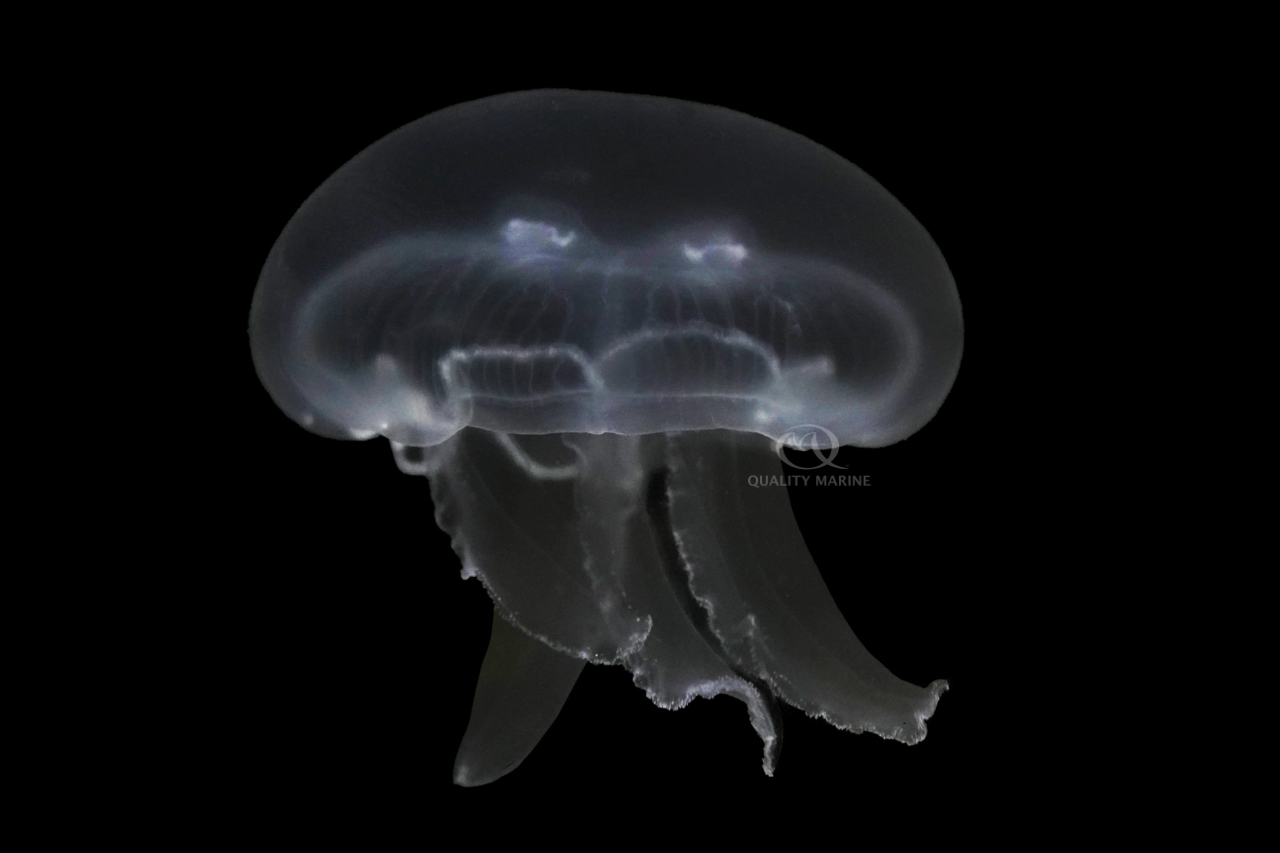Shooting For the Moon

Aurelia aurita is the scientific name (or binomial nomenclature) for one of the world's most common (and beautiful) jellyfish. They are called a few different things, among them “Moon Jelly” is probably the most common, though “Common Jellyfish” and “White Jellyfish” are also sometimes used. In France, they are usually referred to as “Méduse commune” which we also like.

They are found in all the oceans that are warm (and cool) enough to keep them, which is all of them, save the Arctic Ocean. For reasons unknown, they are also conspicuously absent from the west coast of Africa. They are found at a massive range of depths, most commonly they are near the surface because they need shallow substrate for reproduction but have also been documented below 3250 feet down! Aurelia aurita can live in nearly the full range of salinity, from a barely calculable 1.0005 to over 1.030; they seem to do best in salinity over 1.025. The temperature range is similarly mind-blowing, as they are common in waters down to almost 40 degrees Fahrenheit, and up to 70. They are absent from the warmest tropical environments. This will necessitate one of two things for the Jellyfish Hobbyist, either a very consistent and cool fish room that maintains temperatures under 70, or a dedicated chiller. Most quality salt mixes, like Tropic Marin, when mixed according to the instructions and with Reverse Osmosis filtered water, will yield water quality parameters that are perfect for keeping Aurelia aurita. You're looking for a pH that is consistently 8.2 to 8.4, and salinity at 1.025 or 1.026.
Moon Jellies are relatively small, never getting much bigger than a foot across the bell. That outer bell is almost perfectly see-through, which is an excellent camouflage when they are seen from either below or above. There is a second bell within that one, that is also mostly transparent, but has some visible bluish veins that are laid out in a pattern like a four-leaf clover. Shape wise they are very compact from top to bottom as well, with cilia that are almost always less than two inches long, even in the largest adults, though their oral arms can extend below this.

All Jellies have a pretty interesting, albeit short life cycle. Where to start that story is akin to the chicken and the egg, so we'll just start the story with reproduction. As far as humans have been able to discern, there is no courtship event between the males and females, and mating happens all year round whenever local conditions are good; at this point males release sperm filaments in the general vicinity, and “upstream” of females who intercept it and take it in, in a mechanism remarkably like how they feed! (We'll get into food and feeding in a bit). Once the eggs are fertilized, they're called planulae, and these are free swimming for 10 days or so before they attach to a hard surface. They can stay at this stage for a long time, and even reproduce by budding (making clones of themselves) making these jellies one of very few species that can reproduce both sexually and asexually. These polyps develop into adult, free swimming jellies through a few distinct steps and this whole process can take up to six months depending on the conditions (temperature, available food, and salinity among others). Adult Aurelia aurita live for six months to a year on average but have been documented living past two years old in captivity.
In regard to keeping them in captivity, home aquarists will need a dedicated system called a Kreisel Tank to display these critters without having them get sucked into filtration (with predictably disastrous consequences.) What is a Kriesel? Very simply put, it is a circular display that is set up for viewing into the flat plane of the circle. The flow of these tanks is set up to work in a gyre that pushes the Moon Jellies and their food around the central point of the circle while not allowing them to get sucked into filtration. We've recently done a more in-depth article on them which can be seen here: https://www.qualitymarine.com/news/wolf-and-the-je...
Next up in husbandry is how to feed Aurelia aurita (or most other jellies). Moon Jellies feed by immobilizing small prey by utilizing stinging cells called nematocysts. These are located in the four “oral arms” that also help move this prey to the gastric pouches, which have multiple uses for jellies, but for the conversation of feeding, can be thought of as a stomach. The pulsating cilia around the bell of the jelly are also used to help push food toward these oral arms. Luckily for us as aquarists, these arms and cells won't differentiate live food from quality thawed foods, and so these foods just need to be meaty in nature, preferably high in fat and sized correctly for your Jellies to eat. In the wild, they will eat plankton, copepods, small shrimp and fish, so some really great and easily available foods for them in captivity would be things like Gamma Mysis, Gamma Brine Shrimp plus Omega 3s, Gamma Brine Shrimp plus Spirulina, Gamma Rotifers and Gamma Copepods; bigger specimens will also take Gamma Krill, Gamma Chopped Mussel, and even Silversides that are chopped small enough. Start feeding small amounts at a time, while tracking how much you are feeding. One nice thing about feeding jellies is that they are clear, and you can see when they are full! They should be fed at least once a day. Nutramar live brine shrimp and their nauplii (baby brine) are good foods for Jellies, feeding these brine shrimp well will help their nutritional profile.
If you, like us, have become enamored of the large and beautiful Jellyfish displays that many public aquariums like Monterey Bay have, smaller and more manageable versions of these are within your reach. There are a few different choices you could make as far as species of jellyfish for your own aquarium, as long as you don't mix them as Jellies will sting and eat each other! If you're ready for this kind of zen display in your own home, head to your Local Fish Store and talk to them about a Kreisel Tank and some Moon Jellies from Quality Marine today!